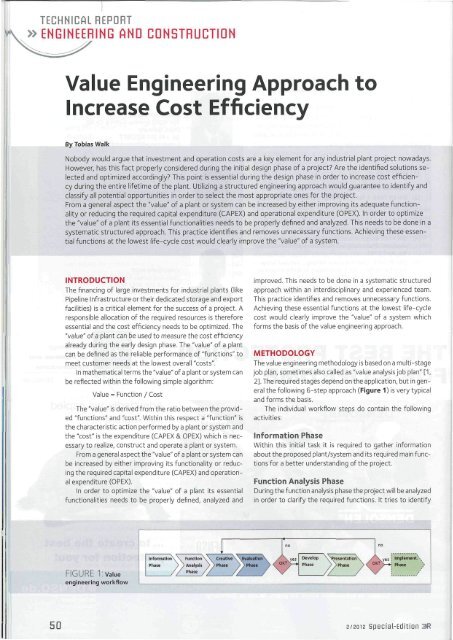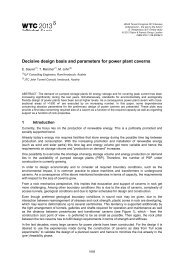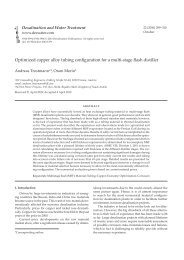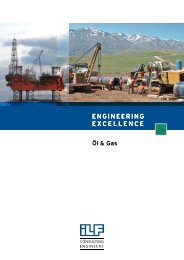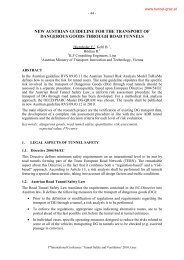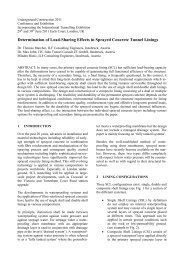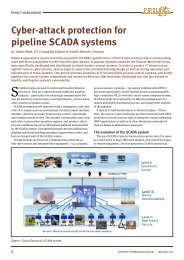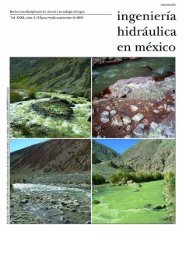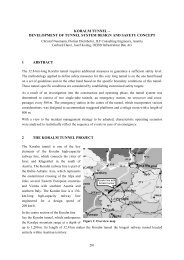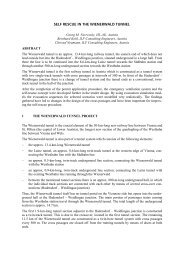Value Engineering Approach to Increase Cost Efficiency
Value Engineering Approach to Increase Cost Efficiency
Value Engineering Approach to Increase Cost Efficiency
Create successful ePaper yourself
Turn your PDF publications into a flip-book with our unique Google optimized e-Paper software.
TECHNICAL REPORT<br />
»ENGINEERING AND CONSTRUCTION<br />
<strong>Value</strong> <strong>Engineering</strong> <strong>Approach</strong> <strong>to</strong><br />
<strong>Increase</strong> <strong>Cost</strong> <strong>Efficiency</strong><br />
By Tobias Walk<br />
Nobody would argue that investment and operation costs are a key element for any industrial plant project nowadays.<br />
However, has this fact properly considered during the initial design phase of a project? Are the identified solutions selected<br />
and optimized accordingly? This point is essential during the design phase in order <strong>to</strong> increase cost efficiency<br />
during the entire lifetime of the plant. Utilizing a structured engineering approach would guarantee <strong>to</strong> identify and<br />
classify all potential opportunities in order <strong>to</strong> select the most appropriate ones for the project.<br />
From a general aspect the "value" of a plant or system can be increased by either improving its adequate functionality<br />
or reducing the required capital expenditure (CAPEX) and operational expenditure (OPEX). In order <strong>to</strong> optimize<br />
the "value" of a plant its essential functionalities needs <strong>to</strong> be properly defined and analyzed. This needs <strong>to</strong> be done in a<br />
systematic structured approach. This practice identifies and removes unnecessary functions. Achieving these essential<br />
functions at the lowest life-cycle cost would clearly improve the "value" of a system.<br />
INTRODUCTION<br />
The financing of large investments for industrial plants (like<br />
Pipeline Infrastructure or their dedicated s<strong>to</strong>rage and export<br />
facilities) is a critical element for the success of a project. A<br />
responsible allocation of the required resources is therefore<br />
essential and the cost efficiency needs <strong>to</strong> be optimized. The<br />
"value" of a plant can be used <strong>to</strong> measure the cost efficiency<br />
already during the early design phase. The "value" of a plant<br />
can be defined as the reliable performance of "functions" <strong>to</strong><br />
meet cus<strong>to</strong>mer needs at the lowest overall "costs".<br />
In mathematical terms the "value" of a plant or system can<br />
be reflected within the following simple algorithm:<br />
<strong>Value</strong> = Function / <strong>Cost</strong><br />
The "value" is derived from the ratio between the provided<br />
"functions" and "cost". Within this respect a "function" is<br />
the characteristic action performed by a plant or system and<br />
the "cost" is the expenditure (CAPEX & OPEX) which is necessary<br />
<strong>to</strong> realize, construct and operate a plant or system.<br />
From a general aspect the "value" of a plant or system can<br />
be increased by either improving its functionality or reducing<br />
the required capital expenditure (CAPEX) and operational<br />
expenditure (OPEX).<br />
In order <strong>to</strong> optimize the "value" of a plant its essential<br />
functionalities needs <strong>to</strong> be properly defined, analyzed and<br />
FIGURE 1: value<br />
engineering workflow<br />
i f<br />
| InformationX \ Functlon\\ Creative\ \Evaluation\ / \ yes<br />
Phase } / Analysis y y Phase yy Phase > / OK? VV<br />
Develop<br />
Phase<br />
Phase //<br />
L _/z<br />
/<br />
improved. This needs <strong>to</strong> be done in a systematic structured<br />
approach within an interdisciplinary and experienced team.<br />
This practice identifies and removes unnecessary functions.<br />
Achieving these essential functions at the lowest life-cycle<br />
cost would clearly improve the "value" of a system which<br />
forms the basis of the value engineering approach.<br />
METHODOLOGY<br />
The value engineering methodology is based on a multi-stage<br />
job plan, sometimes also called as "value analysis job plan" [1,<br />
2]. The required stages depend on the application, but in general<br />
the following 6-step approach (Figure 1) is very typical<br />
and forms the basis.<br />
The individual workflow steps do contain the following<br />
activities:<br />
Information Phase<br />
Within this initial task it is required <strong>to</strong> gather information<br />
about the proposed plant/system and its required main functions<br />
for a better understanding of the project.<br />
Function Analysis Phase<br />
During the function analysis phase the project will be analyzed<br />
in order <strong>to</strong> clarify the required functions. It tries <strong>to</strong> identify<br />
no<br />
\^Presentation\<br />
yj> Phase ><br />
// /<br />
no<br />
; Implement. \<br />
A^p. { Phase y<br />
50 a/EDiE Special-Edition 3R
No<br />
1<br />
TABLE 1! Example for the function analysis<br />
Item<br />
Cooler in<br />
station<br />
recycle<br />
line<br />
(verb)<br />
allow<br />
allow<br />
allow<br />
avoid<br />
Function<br />
(noun)<br />
perfomance test<br />
high compression rates<br />
steady state unit recycle<br />
pressure drop (in main line)<br />
Function<br />
is<br />
provided<br />
what functions are important and which performance characteristics<br />
are required for these functions.<br />
These function analysis activities are typically performed<br />
during a workshop exercise with an interdisciplinary experienced<br />
team. The individual experts will provide input from<br />
their areas of expertise as relevant for the project (e.g.<br />
system designer, senior engineers, plant manager, operation<br />
expert). This thought process is based exclusively on<br />
"function" (e.g. what something "does" and not what it "is").<br />
Also initial alternative ideas might be already generated, registered<br />
and compared during that workshop for the next<br />
phase as shown within Table 1. This exercise is an open discussion<br />
of further improvements rather than a quality evaluation<br />
of the design.<br />
Creative Phase<br />
Within the creative phase it is required <strong>to</strong> generate ideas on<br />
all possible ways <strong>to</strong> achieve the required functions. It is looking<br />
for various alternative solutions <strong>to</strong> achieve the identified<br />
requirements. Ideally this would be a process without any restrictions<br />
or limitations in order <strong>to</strong> pick-up also the possibilities<br />
of new technologies or unconventional solutions.<br />
Evaluation Phase<br />
The evaluation phase is assessing the<br />
ideas and concepts derived from the<br />
creative phase. It will cross-check<br />
and verify if these alternatives do<br />
meet the required functions. During<br />
that phase the feasible and most<br />
promising ones are selected for further<br />
steps.<br />
Development Phase<br />
The identified best ideas / alternatives<br />
from the evaluation phase are<br />
selected and further developed during<br />
that phase. In order <strong>to</strong> improve<br />
the value of the plant a special focus<br />
would be on their impact, what<br />
are the costs and what performance<br />
can be expected?<br />
Presentation Phase<br />
The identified and developed alternative<br />
solutions are presented <strong>to</strong> the<br />
project stakeholders. The presenta<br />
y<br />
n<br />
n<br />
y<br />
Alternative 1<br />
Locate cooler<br />
in main<br />
stream<br />
(potentially<br />
with by-pass)<br />
Does it<br />
fulfill<br />
function?<br />
y<br />
y<br />
y<br />
n(y)<br />
Does it<br />
reduce<br />
cost?<br />
n(n)<br />
Alternative 2<br />
No cooler<br />
Does it Does it<br />
fulfill reduce<br />
function? cost?<br />
tion shall provide all pros and cons of the alternative solutions<br />
and convince the stakeholder <strong>to</strong> follow the recommendations<br />
<strong>to</strong> improve the value of their project or plant. With the<br />
approval of the stakeholders the alternative solutions will be<br />
granted a form part of the project implementation phase.<br />
EXAMPLES<br />
The value engineering approach is possible within various<br />
types of projects and not limited <strong>to</strong> Greenfield project plants<br />
only. It can be used also for Brownfield / Revamp projects<br />
and it's getting more and more popular within this area. Furthermore<br />
the value engineering approach is also not limited<br />
<strong>to</strong> (re-)construction of real industrial plants only as it is also<br />
possible <strong>to</strong> utilize it for the update of company standards. The<br />
following examples are derived from recent projects within<br />
ILF and shall provide a flavour of the variety and its possibilities<br />
<strong>to</strong> utilize the value engineering approach.<br />
Greenfield Projects<br />
Within the Burgas - Alexandroupolis Crude Oil Pipeline<br />
project (in Bulgaria and Greece) an oil transportation mod-<br />
PIGURE /.'. Oil transportation modelling<br />
3R Special-Edition 2/H012 51<br />
n<br />
n<br />
n<br />
y<br />
y<br />
Decision
TECHNICAL REPORT<br />
» ENGINEERING AND CONSTRUCTION<br />
FIGURE 3: <strong>Value</strong> engineering<br />
workflow<br />
within reengineering<br />
project<br />
el has been developed <strong>to</strong> reflect all required functions and<br />
boundary conditions. It defines the amount of oil supply at<br />
Novorossiysk and Sheskharis Terminals, the required black<br />
see shuttle traffic via vessels <strong>to</strong> reach Burgas, the pipeline<br />
transport capacity and it provides the required figures <strong>to</strong> optimizes<br />
the tank farm s<strong>to</strong>rage capacity as well as the marine<br />
facilities (see also Figure 2). The derived key parameters<br />
have been further used <strong>to</strong> determine the optimum pipeline<br />
diameter and the required number of pump stations.<br />
The approach is based on a simulation model which<br />
equips organizations with the ability <strong>to</strong> ask "whatif?" when<br />
making strategic decisions. Simulation's unique time based<br />
approach, in conjunction with the ability <strong>to</strong> reflect the fac<strong>to</strong>rs<br />
that vary, enables models <strong>to</strong> accurately mimic the complexities<br />
of real life systems. As a result, decisionmakers<br />
FIGURE 4:<br />
Screening & condensing<br />
phase<br />
Indent ify<br />
Improvement<br />
Measures<br />
Sub Options<br />
Discuss with Client / Alignment Meetings<br />
can be sure that they have found the solution that strikes<br />
the right balance between capital costs and service levels.<br />
Brownfield Projects / Revamp Projects<br />
In 2011 ILF has been involved as an engineering contrac<strong>to</strong>r<br />
responsible for reengineering and infrastructure optimization<br />
study of the Samotlor field which is the biggest<br />
oil field in the his<strong>to</strong>ry of the Former Soviet Union and one<br />
of the biggest in the world. The Samotlor field is in operation<br />
since 1969 and has produced some 2.3 billion <strong>to</strong>ns of<br />
crude oil until now.<br />
The purpose of the reengineering and Infrastructure optimization<br />
study was:<br />
»<strong>to</strong> ascertain options for infrastructure development of<br />
the Samotlor field in its mature stage of production, al<br />
Formulate<br />
the<br />
Strategic<br />
Concept<br />
Options<br />
A, B,C<br />
Elaborate and Refine the Factsheets<br />
la bora<br />
/ Technical<br />
M-__J!<br />
! Creative Phase ! Screening & Condensing , Combining in<strong>to</strong> Strategic , Assessment or<br />
a 3<br />
Options Option A<br />
Assignment<br />
i " ■ " !<br />
I i i 3 Stragtegic i i<br />
..„„ W Strategic Sub-option Options Oolinn A<br />
143 Sub-Options Pac<strong>to</strong>nr* JT ,<br />
t t racrages (Basecase)<br />
\ (22 Suboption) ;<br />
I I i l l<br />
52 2/2012 SpecialEdition 3R
lowing for improvement of economic indica<strong>to</strong>rs of<br />
field operation;<br />
» <strong>to</strong> optimize expenses for infrastructure mainte<br />
nance in safe mode and without loss of production<br />
throughout the remaining period of operation (esti<br />
mated till 2030)<br />
Within this respect the value engineering approach has<br />
been utilized in this project and the required steps per<br />
formed accordingly (see also Figure 3):<br />
Due <strong>to</strong> the magnitude of the reengineering project<br />
in <strong>to</strong>tal 143 suboptions could be identified during the<br />
creation phase of value engineering approach. In order<br />
<strong>to</strong> better structure and handle this big amount an addi<br />
tional screening & condensing Phase (see also Figure 4)<br />
has been introduced which reduced it <strong>to</strong> ten strategic<br />
suboption packages and finally identified three stra<br />
tegic options, which are based on each other. The base<br />
case was further developed and investigated in detail.<br />
Due <strong>to</strong> the identified base case it was possible <strong>to</strong><br />
identify about 40 % of OPEX savings and <strong>to</strong> increase<br />
the revenue gains (see also Figure 5).<br />
CONCLUSION<br />
Utilizing a structured engineering approach would guar<br />
antee <strong>to</strong> identify and classify all potential opportunities<br />
in order <strong>to</strong> select the most appropriate ones for the<br />
project. The value engineering approach can be uti<br />
lized within various project types <strong>to</strong> increase signifi<br />
cantly the cost efficiency of a plant. Therefore it is an<br />
essential methodology <strong>to</strong> increase the value of a plant<br />
or system at an early stage of a project. The approach<br />
is not limited <strong>to</strong> Greenfield projects and can be adapt<br />
ed also for Brownfield revamp projects or the develop<br />
ment of company standards.<br />
lUEfUmiRL<br />
[1] SAVE International, <strong>Value</strong> Methodology Standard, June<br />
2007 edition, www.valueeng.org<br />
[2] Miles, L. D.: Techniques of value Analysis and <strong>Engineering</strong><br />
AUTHOR<br />
c%<br />
^ tfc<br />
m jfm<br />
3R SpecialEdition 2/2012<br />
TOBIAS WALK<br />
ILF Consulting Engineers GmbH,<br />
Munich, Germany<br />
Tel.+49 89 255594244<br />
EMail: <strong>to</strong>bias.walk@ilf.com<br />
about 40 %<br />
savings<br />
* ■<br />
-OPEX AFTER optimization -^OPEX BEFORE optimization Additional Revenues<br />
FIGURE 5: OPEX savings and revenue gains<br />
ENGINEERING EXCELLENCE<br />
Your Top Consultant for Pipeline Systems<br />
ILF Consulting Engineers operates more than 30 offices worldwide,<br />
now also in Calgary, Canada.<br />
Our fields of competence:<br />
■ Oil & Gas<br />
■ Energy & Climate Protection<br />
■ Water & Environment<br />
■ Transport & Structures<br />
ILF Consulting Engineers<br />
WernerEckertStrasse 7<br />
81829 Munich, Germany<br />
Phone: +49 (89) 25 55 94 0<br />
Fax: +49 (89) 25 55 94 144<br />
postmaster@ilf.com<br />
Our services:<br />
■ Consultancy<br />
■ Design & planning<br />
■ Procurement<br />
■ Project management<br />
■ Construction supervision<br />
■ Startup<br />
■ Special services<br />
tug<br />
CONSULTING<br />
ENGINEERS


